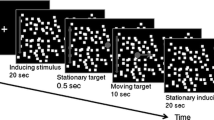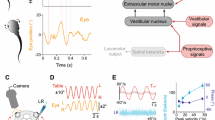Abstract
OPTOKINETIC nystagmus can be elicited in humans and in many animals by presenting a moving optic pattern, for example, of vertical stripes moving horizontally at constant velocity. The eyes follow (“pursue”) the pattern at an angular velocity that may approach or equal that of the moving stripes: this ocular pursuit movement (the “slow phase” of the optokinetic nystagmus) tends to stabilize the position of the image on the retina1–3. Each pursuit movement is terminated by a rapid, “saccadic” ocular return movement (the “fast phase”) that transports the image to a new retinal location1–3. Alternation of slow-phase movements in one direction with fast-phase movements in the opposite direction results in an oscillatory eye movement pattern called a nystagmus. Mammalian optokinetic nystagmus is normally conjugate4,5, that is, the two eyes move in unison, as if yoked; however, we do not think the extent to which the pattern of optokinetic nystagmus is conjugate in the infra-mammalian vertebrate has been clearly determined.
Similar content being viewed by others
References
Rademaker, G. G. J., and ter Braak, J. W. G., Brain, 71, 59 (1948).
Reinecke, R. D., Arch. Ophthalmol., 65, 171 (1961).
Alpern, M., in The Eye (edit. by Davson, H.), 3, 82, 90 (Academic Press, New York, 1962).
Duke-Elder, S., in System of Ophthalmology (edit. by Duke-Elder, S.), 1, 692 (C. V. Mosby Co., St. Louis, 1958).
Walls, G. L., The Vertebrate Eye, 300, 306, 310 (Haffner Pub. Co., New York, 1963).
Verheijen, F. J., Experientia, 15, 443 (1959).
Huizinga, E., and Meulen, P., Ann. Otol. Rhino. and Laryng., 60, 927 (1951).
Pasik, P., Pasik, T., and Krieger, H. P., J. Neurophysiol., 22, 297 (1959).
Author information
Authors and Affiliations
Rights and permissions
About this article
Cite this article
TAUBER, E., ATKIN, A. Disconjugate Eye Movement Patterns during Optokinetic Stimulation of the African Chameleon, Chameleo melleri. Nature 214, 1008–1010 (1967). https://doi.org/10.1038/2141008b0
Received:
Revised:
Published:
Issue Date:
DOI: https://doi.org/10.1038/2141008b0
- Springer Nature Limited
This article is cited by
-
A distributed saccade-associated network encodes high velocity conjugate and monocular eye movements in the zebrafish hindbrain
Scientific Reports (2021)
-
Gaze stabilization in mantis shrimp in response to angled stimuli
Journal of Comparative Physiology A (2019)
-
Conjugate and disjunctive optokinetic eye movements in the rabbit, evoked by rotatory and translatory motion
Pfl�gers Archiv European Journal of Physiology (1972)





